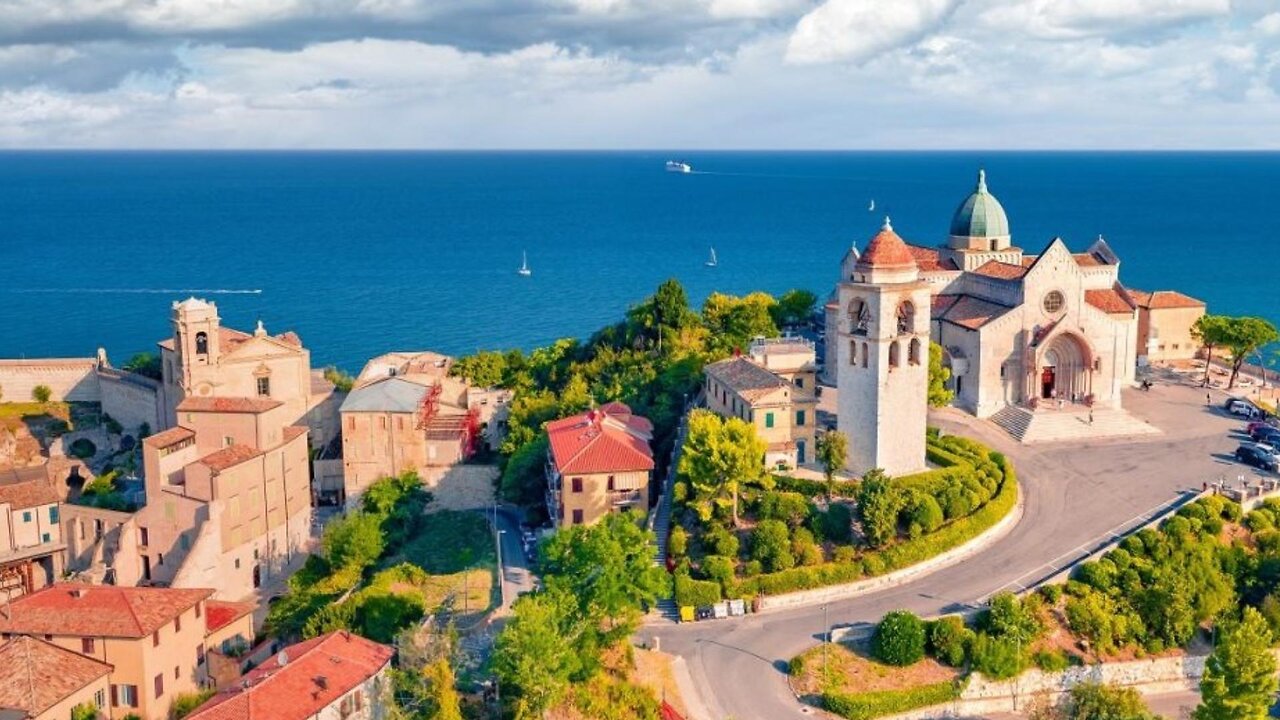Premium Only Content

Ancona: From Dorians to Europe (AUD ENG)
Ancona is a city and a seaport in the Marche region of central Italy, with a population of around 101,997 as of 2015. Ancona is the capital of the homonymous province and of the region. The city is located 280 km (170 mi) northeast of Rome, on the Adriatic Sea, between the slopes of the two extremities of the promontory of Monte Conero, Monte Astagno and Monte Guasco. The hilly nature around Ancona is a strong contrast to the flatter coastline in areas further north. Ancona is one of the main ports on the Adriatic Sea, especially for passenger traffic, and is the main economic and demographic centre of the region.
Before the Greek colonization, the territory was occupied by separated communities of the Picentes tribes. Ancona took a more urban shape by Greek settlers from Syracuse in about 387 BC, who gave it its name: Ancona stems from the Greek word Ἀνκών (Ankṓn), meaning "elbow"; the harbour to the east of the town was originally protected only by the promontory on the north, shaped like an elbow. Greek merchants established a Tyrian purple dye factory here.[8] In Roman times it kept its own coinage with the punning device of the bent arm holding a palm branch, and the head of Aphrodite on the reverse, and continued the use of the Greek language.
When it became a Roman town is uncertain. It was occupied as a naval station in the Illyrian War of 178 BC. Julius Caesar took possession of it immediately after crossing the Rubicon. Its harbour was of considerable importance in imperial times, as the nearest to Dalmatia, and was enlarged by Trajan, who constructed the north quay with his architect Apollodorus of Damascus. At the beginning of it stands the marble triumphal arch, the Arch of Trajan with a single archway, and without bas-reliefs, erected in his honour in 115 by the Senate and Roman people.
Ancona was attacked successively by the Goths and Lombards between the 3rd and 5th centuries, but recovered its strength and importance. It was one of the cities of the Pentapolis of the Exarchate of Ravenna, a lordship of the Byzantine Empire, in the 7th and 8th centuries. In 840, Saracen raiders sacked and burned the city. After Charlemagne's conquest of northern Italy, it became the capital of the Marca di Ancona, whence the name of the modern region derives.
After 1000, Ancona became increasingly independent, eventually turning into an important maritime republic (together with Gaeta and Ragusa, it is one of those not appearing on the Italian naval flag), often clashing against the nearby power of Venice. An oligarchic republic, Ancona was ruled by six Elders, elected by the three terzieri into which the city was divided: S. Pietro, Porto and Capodimonte. It had a coin of its own, the agontano, and a series of laws known as Statuti del mare e del Terzenale and Statuti della Dogana. The Republic of Ancona enjoyed excellent relations with the Kingdom of Hungary, was an ally of the Republic of Ragusa, and maintained good relations with the Ottoman Empire. All these relationships enabled it to serve as central Italy's gateway to the Orient.
Included in the Papal States since 774, Ancona came under the influence of the Holy Roman Empire around 1000, but gradually gained independence to become fully independent with the coming of the communes in the 11th century, under the high jurisdiction of the papal state. Its motto was Ancon dorica civitas fidei ('Dorian Ancona, city of faith'), referencing the Greek foundation of the city.
In 1137, 1167 and 1174 it was strong enough to push back the forces of the Holy Roman Empire. Anconitan ships took part in the Crusades, and their navigators included Cyriac of Ancona. In the struggle between the Popes and the Holy Roman Emperors that troubled Northern and central Italy from the 12th century onwards, Ancona sided with the Popes (Guelphs). Unlike other cities of northern Italy, Ancona never became a signoria. The sole exception was the rule of the Malatesta, who took the city in 1348, taking advantage of the black death and of a fire that had destroyed many of the city's important buildings. The Malatesta were ousted in 1383. In 1532, Ancona definitively lost its freedom and became part of the Papal States, under Pope Clement VII. The symbol of the new papal authority was the massive Citadel.
Ancona, as well as Venice, became a very important destination for merchants from the Ottoman Empire during the 16th century. The Greeks formed the largest of the communities of foreign merchants. They were refugees from former Byzantine or Venetian territories that were occupied by the Ottomans in the late 15th and 16th centuries. The first Greek community was established in Ancona early in the 16th century.
-
 45:48
45:48
Adaneth - History&Politics
3 days agoGeorge Washington - Founding Father
49 -
 LIVE
LIVE
The Jimmy Dore Show
8 minutes agoMamdani’s BIG WIN for the Powerful! Candace Owens SHOCKER About Kirk Assassination! w/ Russ Dobular
4,390 watching -
 LIVE
LIVE
Kim Iversen
1 hour agoAmerica Under INVASION - Sharia Law Wins In New York City?
8,368 watching -
 50:45
50:45
Redacted News
1 hour agoNick Fuentes & Tucker Carlson DESTROY Ben Shapiro, Cuomo collapses to a socialist | Redacted
10.5K26 -
 LIVE
LIVE
Dr Disrespect
6 hours ago🔴LIVE - DR DISRESPECT - BATTLEFIELD 6 - REDSEC - 10 WINS CHALLENGE
3,439 watching -
 LIVE
LIVE
Akademiks
1 hour agoAdin Ross x 6ix9ine x Akademiks stream
699 watching -
 LIVE
LIVE
StoneMountain64
3 hours agoBattlefield REDSEC HARDCORE, Ultra Movement, and CRAZY Portal Games
112 watching -
 1:09:44
1:09:44
Russell Brand
6 hours agoFrom Curb Your Enthusiasm to Courage — Cheryl Hines on Hollywood, RFK Jr. & Speaking Out - SF646
124K22 -
 1:30:26
1:30:26
The Quartering
4 hours agoWoke Is Back!
117K44 -
 1:18:21
1:18:21
DeVory Darkins
5 hours agoTrump issues CHILLING WARNING to GOP as SCOTUS hears arguments regarding Tariffs
108K97